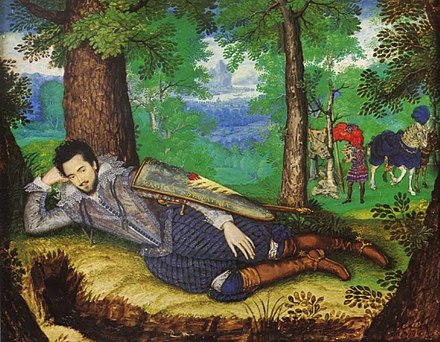Powis Castle
Powis Castle (Welsh: Castell Powys) is a medieval castle, fortress and grand country house near Welshpool, in Powys, Wales. The seat of the Herbert family, earls of Powis, the castle is known for its formal gardens and for its interiors, the former having been described as "the most important", and the latter "the most magnificent", in the country. The castle and gardens are under the care of the National Trust. Powis Castle is a Grade I listed building, while its gardens have their own Grade I listing on the Cadw/ICOMOS Register of Parks and Gardens of Special Historic Interest in Wales.
The present castle was built in the 13th century. Unusually for a castle on the Marches, it was constructed by a Welsh prince, Gruffydd ap Gwenwynwyn, rather than by a Norman baron. Gruffydd was prince of the ancient Kingdom of Powys and maintained an alliance with the English king Edward I during the struggles of the later 13th century. He was able to secure the position of his son, Owain, although the kingdom itself was abolished by the Parliament of Shrewsbury in 1283. After his father's death, Owain was raised to the peerage as Owen de la Pole, 1st Lord of Powis. Following his own death c. 1293, and the death of his only son, he was succeeded by his daughter, Hawys Gadarn, "the Lady of Powis". Hawys married Sir John Charlton in 1309.
In the late 16th century the castle was purchased by Edward Herbert, a younger son of the earl of Pembroke, beginning a connection between the family and the castle that continues today. The Herberts remained Roman Catholic until the 18th century and, although rising in the peerage to earls, marquesses and Jacobite dukes of Powis, suffered periods of imprisonment and exile. Despite these setbacks, they were able in the late 17th and early 18th centuries to transform Powis from a border fortress into an aristocratic country house, and surround it with one of the very few extant examples of a British Baroque garden.
In 1784 Henrietta Herbert married Edward Clive, eldest son of Clive of India, a match which replenished the much-depleted Herbert family fortune. In the early 20th century, George Herbert, 4th Earl of Powis redeveloped the castle with the assistance of the architect George Frederick Bodley. Herbert’s wife, Violet, undertook work of equal importance in the garden, seeking to turn it into "one of the most beautiful, if not the most beautiful, in England and Wales". On the 4th earl's death in 1952, his wife and his sons having predeceased him, the castle passed into the care of the National Trust.
Unlike the castles at Conwy, Caernarfon, Harlech and nearby Montgomery, which were built by the English to subdue the Welsh, the castles at Welshpool were built by the Welsh princes of Powys Wenwynwyn as their dynastic seat.[1] In addition to the current site, two motte-and-bailey castles and a set of earthworks are located nearby.[2] The names Trallwg/Tallwm and Pola are used interchangeably in early primary sources, and it is unclear which of these sites is being referred to.[3]
The earliest reference dates from 1111, when Cadwgan ap Bleddyn is mentioned as having planned to construct a castle at Trallwng Llywelyn,[3] the oldest record of a native Welsh castle.[4] Domen Castell, a motte-and-bailey near the modern railway station, is considered the most likely site of Cadwgan's castle, although it is uncertain whether it was completed as he was assassinated the following year.[5] The first documentary account of an extant castle at Welshpool is a description of the successful 1196 siege by an English army, although the castle was retaken by the Welsh within the year.[5][6]
